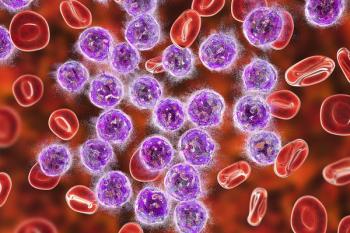
Old Age ‘Should Not Prohibit’ Cellular Therapy Use in Large B-Cell Lymphoma
Axicabtagene ciloleucel may prolong survival and improve outcomes vs standard-of-care therapy in older patients with relapsed/refractory large B-cell lymphoma.
The CD19-directed CAR T-cell therapy axicabtagene ciloleucel (axi-cel; Yescarta) outperformed high-dose chemotherapy and autologous stem cell transplantation (ASCT) in a cohort of patients aged 65 years or older with relapsed/refractory large B-cell lymphoma (LBCL), according to findings from a subgroup analysis of the phase 3 ZUMA-7 trial (NCT03391466).
Treatment with axi-cel produced a median event-free survival (EFS) of 21.5 months (95% CI, 5.0-not estimable [NE]) compared with a median of 2.5 months (95% CI, 1.6-3.2) with standard-of-care high-dose chemotherapy and ASCT. The EFS rate at 24 months was 47.8% (95% CI, 33.2%-61.0%) in the experimental arm and 15.1% (95% CI, 7.1%-25.8%) in the control arm. Additionally, multivariate analyses mirrored these results when adjusting for differences in baseline characteristics (HR, 0.23; 95% CI, 0.12-0.45; P <.0001).
The objective response rate (ORR) was 88% with axicabtagene ciloleucel vs 52% with standard-of-care therapy (odds ratio [OR], 8.81; 95% CI, 2.71-32.14; P <.0001). The odds of an objective response remained higher with the experimental regimen even after adjusting for differences in baseline characteristics (OR, 9.61; 95% CI, 2.54-36.32; P <.001). The rates of complete response (CR) were 75% vs 33%, respectively, in the experimental and control arms (OR, 8.95; 95% CI, 2.78-25.02; P <.0001).
Median progression-free survival (PFS) was 21.5 months (95% CI, 5.1-NE) with axi-cel and 5.0 months (95% CI, 2.8-7.3) with standard-of-care therapy (HR, 0.384; 95% CI, 0.214-0.691; P = .0005). Median overall survival (OS) was also longer in the experimental arm than the control arm (HR, 0.517; 95% CI, 0.277-0.964).
“Patients [aged] 65 years [and older] may be ineligible for stem cell transplantation due to an increased risk for toxicity or mortality, or due to regional and/or institutional guidelines that limit stem cell transplantation based upon age,” the investigators wrote. “In this analysis, axi-cel demonstrated superior efficacy over standard of care in patients [aged] 65 years [and older] despite greater frequency of high-risk features in the [experimental] arm vs the [control] arm…establishing a new standard-of-care therapeutic option.”
This preplanned subgroup analysis included 109 patients aged 65 years or older of the 359 patients enrolled in ZUMA-7.Most of this subgroup (70%) had primary refractory disease. Of this population, 51 received the experimental treatment and 58 received standard-of-care therapy. Demographic and disease characteristics were generally well-balanced between the two groups.
However, several high-risk disease features were more prevalent in the experimental arm than in the control arm. A total of 53% vs 31% of patients had second-line age-adjusted International Prognostic Index of 2 to 3, elevated lactate dehydrogenase occurred in 61% vs 41%, and high-grade B-cell lymphoma occurred in 33% vs 14%, respectively.
The median age in the overall subgroup was 69 years old (range, 65-81). Most patients were male (61%), and the vast majority were White (93%). Overall, 6% of patients identified as Hispanic or Latino.
As part of the ZUMA-7 trial, patients in the experimental arm received conditioning chemotherapy consisting of cyclophosphamide at a dose of 500 mg/m2 and fludarabine at a dose of 30 mg/m2 daily at 5, 4, and 3 days prior to axi-cel infusion. They underwent leukapheresis prior to this regimen, and the target CAR T dosage was 2x106 cells/kg. Patients in the control arm, meanwhile, underwent 2 to 3 cycles of investigator-selected, platinum-based chemoimmunotherapy; those with a complete or partial response then proceeded to high-dose chemotherapy and ASCT.
The primary end point was EFS. Secondary end points included ORR, OS, PFS, and toxicity.
Treatment-emergent adverse effects (TEAEs) of grade 3 or higher occurred in 94% of patients in the experimental arm and 82% of those in the control arm. The most common of these TEAEs was neutropenia, which occurred in 80% of axi-cel patients and 44% of standard-of-care patients. Serious AEs occurred in 59% and 47% of patients, respectively, and prolonged cytopenias of grade 3 or higher occurred in 12% and 10%, respectively.
Cytokine release syndrome (CRS) occurred in 98% of those who received axi-cel, with CRS of grade 3 or higher observed in 8%. The median time to CRS onset was 3 days (range, 1-10), and the median duration was 8 days (range, 3-22). Neurologic events of any grade occurred in 65% of patients in the experimental arm vs 25% in the control arm, with events of grade 3 or higher observed in 27% vs 2% in the axi-cel and chemotherapy arms, respectively.
The analysis also assessed outcomes in patients aged 70 years or older (n = 53/109). The EFS rate at 12 months in this population was 42.3% (95% CI, 23.5%-60.0%) with axi-cel vs 3.7% (95% CI, 0.3%-15.9%) with standard-of-care therapy. The ORR was 88% vs 41%, respectively (P <.001), and the CR rate was 69% vs 22%, respectively (P <.01).
“Taken together, these data suggest that age should not prohibit the consideration of cellular therapy for patients with LBCL,” the investigators concluded.
Reference
Westin JR, Locke FL, Dickinson M, et al. Safety and efficacy of axicabtagene ciloleucel versus standard of care in patients 65 years of age or older with relapsed/refractory large B-cell lymphoma. Clin Can Res. 2023;29(10):1894-1905. doi:10.1158/1078-0432.CCR-22-3136
Newsletter
Stay up to date on recent advances in the multidisciplinary approach to cancer.





















































































